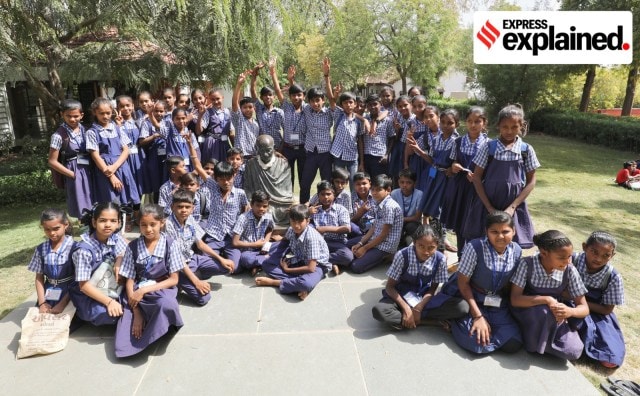Do Muslims have more children than others? Here’s what available data show
The Prime Minister has alleged that the Congress wants to give away the people's wealth to 'those who have more children'. This is what data on Muslim household sizes and growth of Muslim population suggest.
 School children during a visit to Gandhi Ashram in Sabarmati in March 2024. (Representational image/Nirmal Harindran)
School children during a visit to Gandhi Ashram in Sabarmati in March 2024. (Representational image/Nirmal Harindran) Prime Minister Narendra Modi said at an election meeting in Rajasthan on Sunday (April 21) that the Congress intends to distribute the people’s wealth to “infiltrators” and “those who have more children”. His reference was to Muslims.
Census data on religious groups is now 13 years old, and no reliable updated figures about religious groups is available. Some related data points are as follows:
Growth of India’s Muslim population
The population of Muslims was 17.22 crore in the Census of 2011, which was 14.2% of India’s population of 121.08 crore at the time.
The population of Muslims in the previous Census (2001) was 13.81 crore, which was 13.43% of the population of India (102.8 crore) at the time.
The population of Muslims increased by 24.69% between 2001 and 2011. This was the slowest increase in the population of Muslims in India’s history. Between 1991 and 2001, India’s Muslim population increased by 29.49%.
Average household size among religious groups
According to data from the National Sample Survey 68th round (July 2011-June 2012), the average household size of major religious groups was as follows:
| Religion | Household size |
| Hindu | 4.3 |
| Islam | 5 |
| Christianity | 3.9 |
| Sikhism | 4.7 |
| Others | 4.1 |
| All | 4.3 |
Source: Employment and unemployment situation among major religious groups in India, NSS 68th round
Labour Force Participation Rate, Worker Population Ratio, Unemployment Ratio among Muslims
The Labour Force Participation Rate (LFPR) and Worker Population Ratio (WPR) for Muslims is the lowest amongst all religious groups. It is also the only religious group whose LFPR and WPR is falling, as per the National Sample Survey Office (NSSO). The Unemployment Rate (UR) among Muslims is, however, lower than the All-India number.
LFPR is defined as the percentage of persons in the labour force (i.e. working or seeking or available for work) in the population. WPR is defined as the percentage of employed persons in the population. UR is the percentage of unemployed persons among the persons in the labour force.
| All India Male | All India Female | All India Person | Muslim Male | Muslim Female | Muslim Person | |
| Labour Force Participation Rate | 58.1 | 30.5 | 44.5 | 47.7 | 14.2 | 32.5 |
| Worker Population Ratio | 56.1 | 29.6 | 43.1 | 46.6 | 13.8 | 31.7 |
| Unemployment rate | 3.4 | 2.8 | 3.2 | 2.3 | 2.6 | 2.4 |
Source: Annual Report, Periodic Labour Force Survey (PLFS) July 2022-June 2023
- 01
- 02
- 03
- 04
- 05






































